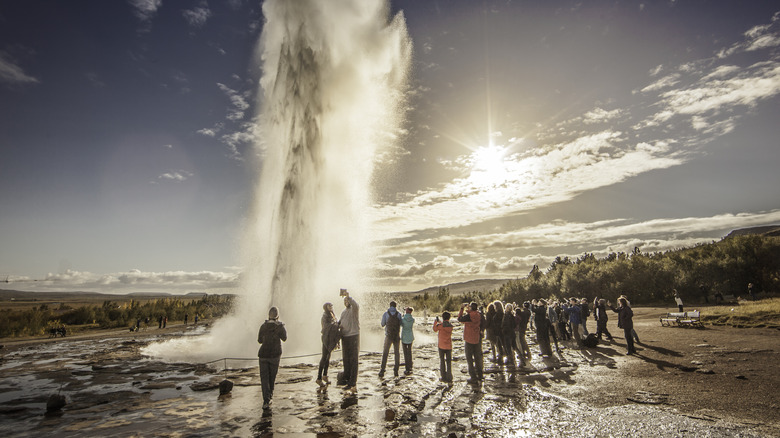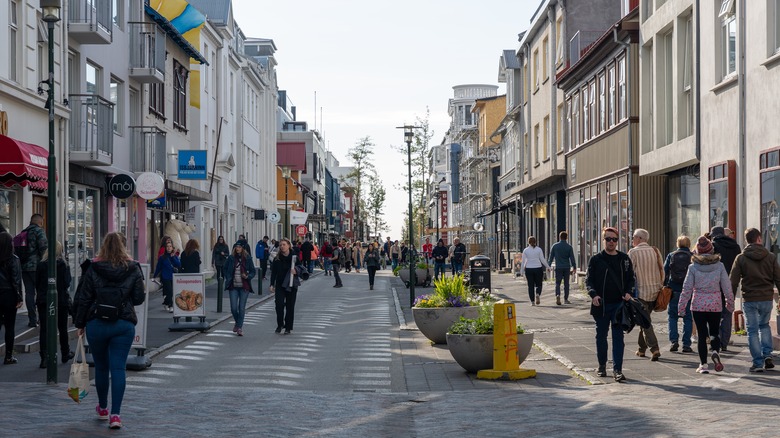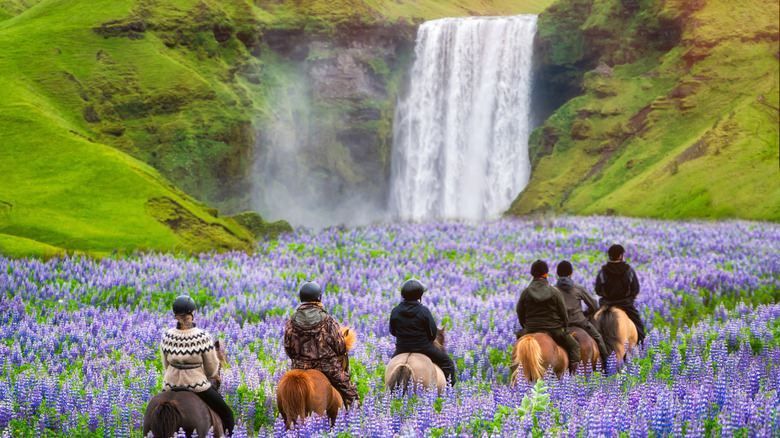Rick Steves Says This Hated Aspect Of Traveling Can Actually Enhance An Iceland Trip
Iceland is arguably one of the most unique destinations in the world. Volcanos, waterfalls, glaciers, beaches — the island nation has it all. Tourists flock to the Nordic country to visit the best stops on its famous Ring Road, bathe in the iconic Blue Lagoon, and spot puffins and other wildlife. Unsurprisingly, these attractions can lead to crowds, especially during peak tourist periods.
However, that doesn't have to be a bad thing, according to seasoned traveler Rick Steves. The expert on all things European travel shared an Iceland itinerary on his website after spending a week in the country in 2018 and noted some of his observations from the trip. One unexpected insight: Mobs of tourists can actually be kind of fun in Iceland. He wrote, "It's true that Iceland sometimes feels like the land of monetized waterfalls, with the most famous natural wonders attracting hordes of tourists — but I found that the crowds were a fun part of the experience."
Steves added that unlike the crowds found in Italy, France, and Spain, large groups of tourists in Iceland tend to be more jovial, "like a big party." When you're seeing something as special as the northern lights or natural blue ice caves, it can be comforting to have other people — and even complete strangers — around to share the moment with. This is especially true given how lonely and desolate many parts of the island can be.
Tourists in Iceland are fun, but don't forget about overtourism
If we're to put faith in the words of Rick Steves, Iceland seems to be one of the few places on the globe where you might just hope to find crowds of tourists. The travel guru also noted that popular spots in Iceland have adapted to accommodate more tourists with expanded parking lots and visitor centers. Unfortunately, some locals may argue that this doesn't tell the whole story.
Overtourism has been a concern in Iceland for years after the country became a magnet for adventurous travelers and amateur photographers. The Nordic nation has had to deal with graffiti, litter, and environmental degradation caused by tourists — damage that threatens Iceland's reputation for untouched, otherworldly scenery. There are also ramifications for locals, particularly when it comes to housing. Some Icelanders have been priced out of the rental market as properties become hotels and short-term accommodations for tourists. Additionally, tourism-driven development often doesn't reflect authentic Icelandic culture. In Reykjavík, it's becoming increasingly common to see fast fashion retailers and puffin shop tourist traps rather than authentic mom-and-pop shops.
In 2024, Iceland reintroduced a tourist tax scheme, where guests must pay an additional fee when booking a hotel, campsite, cruise, or other accommodation. The goal is to control tourist numbers and raise funds for environmental preservation. In the future, the tax may be increased during peak periods to put a cap on crowds.
When is Iceland most crowded?
Whether you've decided you want to time your Iceland vacation for when you'll have the most company, or you'd prefer to explore when it's quiet to make sure you're not contributing to overtourism, it helps to get familiar with the tourism trends in the Land of Fire and Ice. Generally, the high season in Iceland falls between June and August when the weather is mild and more attractions are open. The winter draws the fewest travelers, though it's also known to be cold and dark for much of the day. The shoulder seasons offer the best of both worlds: moderately comfortable conditions with more sunshine and smaller groups of tourists at the famous sites. These periods occur between September and October in the fall and between April and June in the spring.
No matter when you go, you likely won't run into intense, competitive crowds like you would in, say, France — a point Rick Steves touched on. In 2023, about 2.2 million foreign visitors were recorded in Iceland, according to the Icelandic Tourist Board. Compare this figure to the Eiffel Tower, a single attraction in Paris that welcomes a whopping 7 million tourists per year. You may still have to share a view or hiking trail with other travelers in Iceland, but it shouldn't ruin the experience. As Steves suggests, it may even enhance your trip.


